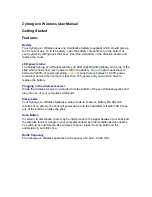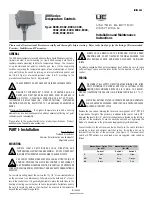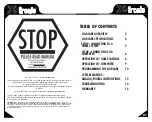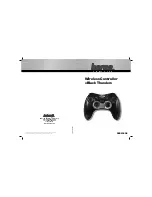
Chapter 9
248
Logic programming – Function blocks
Input parameters and input signals of the function block
Stop request
The
Stop request
parameter determines the Stop state of the Press automatic
function block. If this parameter is configured as
When Start/Release input is Low
,
the
Start/Release
input signal is used to control the
Enable
output directly. If
configured to
When Stop input is High
, the
Enable
output changes to Low, when the
Stop request
input is High.
In both cases the
Enable
output changes to High, when the following conditions are
fulfilled:
A transition from Low to High occurs at the
Start/Release
input; and
the
Stop request
input is Low, if it is connected; and
no other reason is present that would normally trigger a stop signal, e.g.
Release 1
(static)
is Low.
Do not use the Start/Release and Stop inputs for safety stops!
Independent of the configured stop request mode, the inputs
Start/Release
and
Stop
request
must not be used for initiating safety stops. These inputs can only be used for
setting automation control stop requests. Signals initiating safety stops (e.g. safety
stop) must be connected to the
Release 1 (static)
input of the function block.
Upstroke input
If the
Upstroke input
parameter is configured as
With
, a High signal at the
Upstroke
input allows the press to stop both during the downstroke and in the top position. If this
parameter is set to
Without
, regular stops are only possible in the top position.
Connect the
Upstroke
input only to the
Upstroke
output of an Eccentric press contact
or a Universal press contact function block.
Start/Release
The
Start/Release
input signal is used to provide signals for the beginning and end of
the press movement. If a rising edge (Low to High) is detected at the
Start/Release
input, the
Enable
output becomes High, provided that the
Stop request
input is Low
and no other reason is present that would normally trigger a stop signal, e.g.
Release
1 (static)
is Low. A valid restart sequence can be required before a signal transition of
Start/Release
if the
Restart interlock after stop condition
parameter is set to
With
.
If you connect a command device (e.g. a two-hand control) to the
Start/Release
input,
you must ensure that unintentional restarting is not possible.
Stop request
If the
Stop request
parameter is set to
When Stop input is High
, the
Stop request
input is used to signal a stop to the press. When the
Stop request
input is High, the
Enable
output is set to Low.
This input should only be used if the
Stop request
parameter has been set to
When
Stop input is High
. The
Stop request
input is not used when the
Stop request
parameter has been set to
When Start/Release input is Low
. A valid restart
sequence can be required before a signal transition of
Start/Release
when the
Restart interlock after stop condition
parameter is set to
With
. The
Stop request
input is designed for the connection of signals that are not safety-relevant (e.g. from a
programmable controller). Safety-relevant signals may only be connected to the
Release 1 (static)
input, not to the
Stop request
input.
ATTENTION
Note
Summary of Contents for SW1DNN-WS0ADR-B
Page 2: ......
Page 288: ...Chapter 15 285 Annex ...
Page 289: ...Chapter 15 286 Annex ...
Page 290: ...Chapter 15 287 Annex ...
Page 291: ...Chapter 15 288 Annex ...
Page 292: ...Chapter 15 289 Annex ...
Page 293: ...Chapter 15 290 Annex ...
Page 294: ...Chapter 15 291 Annex ...
Page 295: ...Chapter 15 292 Annex ...
Page 296: ...Chapter 15 293 Annex ...
Page 297: ...Chapter 15 294 Annex ...
Page 298: ...Chapter 15 295 Annex 15 1 2 Example application Wood scanner ...
Page 299: ...Chapter 15 296 Annex ...
Page 300: ...Chapter 15 297 Annex ...
Page 301: ...Chapter 15 298 Annex ...
Page 302: ...Chapter 15 299 Annex ...
Page 303: ...Chapter 15 300 Annex ...
Page 304: ...Chapter 15 301 Annex ...
Page 305: ...Chapter 15 302 Annex ...
Page 306: ...Chapter 15 303 Annex ...
Page 307: ...Chapter 15 304 Annex 15 1 3 Example application Ramp down detection ...
Page 308: ...Chapter 15 305 Annex ...
Page 309: ...Chapter 15 306 Annex ...
Page 310: ...Chapter 15 307 Annex ...
Page 311: ...Chapter 15 308 Annex ...
Page 312: ...Chapter 15 309 Annex ...
Page 313: ...Chapter 15 310 Annex ...
Page 314: ...Chapter 15 311 Annex ...
Page 321: ......
















































